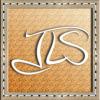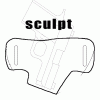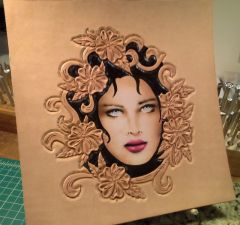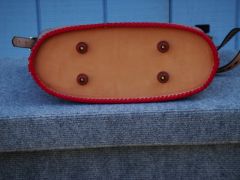-
Posts
7,378 -
Joined
Content Type
Profiles
Forums
Events
Blogs
Gallery
Everything posted by JLSleather
-
Most of the "dimple" appears to be from the leather being pushed into the bottom foot. Still, I think I would increase the top tension just slightly. You ideally want to NOT see the knots.
-

Pretty Straightforward
JLSleather replied to JLSleather's topic in Gun Holsters, Rifle Slings and Knife Sheathes
Thanks, Bob. Probably should have boogered it a bit - I think the wench wife is going to buy one of these pistols now! -

Pretty Straightforward
JLSleather replied to JLSleather's topic in Gun Holsters, Rifle Slings and Knife Sheathes
I don't really have ONE reason why the belt slots are the way they are. Just the way we decided to do it with THAT model. General rule is -- keep it as small as possible while retaining the strength to support the weapon. In fact, size was rather the point of that Sig, yes? Otherwise, if you just need a 9mm, might as well go with a 5" barrel for the distance. Oversimplified, the leading edge slot is generally 'started' in line with the pistol slide. I say started, cuz it has happened where i put it in like that and didnt care for it. All the while, keeping a good bit outside the slot. But here's a sketch - with that general form, and slots vertical. The slots are as close to the weapon as they can be. But, obviously, not much left outside the slot - so how long before that becomes an issue.. So, you need to beef that up a bit, one way or another. Most common, stretch or sculpt. I personally think stretched looks . well.. less than thoughtful.. and sculpted, while doable, adds considerable time to the rig. -

Walther Blue
JLSleather replied to JLSleather's topic in Gun Holsters, Rifle Slings and Knife Sheathes
Yep, that WAS the question. He said 4", but you know how that goes. They say they need a 38 belt too But, he DID say he had the 9mm, so we should be good. I didn't realize i didn't have one until he asked - nobody around here has 'em, or at least admits it! Worst case, it doesn't fit and he can send it back. No harm. 'Preciate the response, and the response time! -
I see ONE blue gun for the PPQ. Anybody know which model it is? I didn't see an email ...
-

Pretty Straightforward
JLSleather replied to JLSleather's topic in Gun Holsters, Rifle Slings and Knife Sheathes
Thanks, fellas. Here's a "happy accident" I kinda liked. It was actually stitched with unwaxed white thread and then dip dyed black. Apparently the coating on the thread kept it from getting flat black. While I certainly didn't plan it, I'm hoping that will do that again! This one was for the Colt Commander. -

Help! Wanted Techsew Stitching Nirvana, Got The Blahs Instead
JLSleather replied to YinTx's topic in Leather Sewing Machines
Checking in a bit - couple things I need to pop out so they can be drying .. According to this book (which does not say techsew) 21 is a "roller follower" and 7 is a presser bar guide bracket. I'll get you the part numbers (at least what they were when this 'edition' was printed) in a bit. $8 says that part number is valid whether it says techsew, cobra, cowboy, blahblah, and prolly some others too. -
No hype. No frills. No kiddin. Jus' soiid leather, done with a bit of care. Purdy. Straight. Forward ....
-

Help! Wanted Techsew Stitching Nirvana, Got The Blahs Instead
JLSleather replied to YinTx's topic in Leather Sewing Machines
That discolored area is your shuttle race. I don't know if that level of heat could ever be produced by operating the machine - even if it was oiled , say.. never. More likely, that part was broken (by impact) and received a less than stellar repair. You may be able to see an issue by removing it from the machine, setting it upside down so the bobbin assembly can turn in there, and then turning the shuttle / bobbin. I'm not there, but just looking at a picture, wouldn't be surprised to see a welded race had warped enough to cause picture 2. Guessin, still. The machine in the video doesn't say techsew, at least not above the paint job. Still, an idea of how that might look working. White thread used on top / black on bobbin just for easy viewing... https://www.youtube.com/watch?v=n7MVSikaYEk That other part, not sure which parts you are describing. what I THINK you are calling 'collar that rides the presser foot" is in fact a clamp (of sorts), and I'm not trying to be insulting when I say I assume that you have checked those screws for tightness. -
-
-

Consew 227 Needle Hitting Bobbin Case
JLSleather replied to jessie1129's topic in Leather Sewing Machines
Does the 227 use a spring inside the bobbin case? If that's missing, that will allow the bobbin to "spool" -
Uhhh... that listing is like a year old?
-

Fillet Knife Sheath Dilemma
JLSleather replied to jellyroll's topic in Gun Holsters, Rifle Slings and Knife Sheathes
I like Charlie's design above, too, but I wonder if there's anything wrong with the idea of putting the stitched seam in FRONT on this one? -
I prefer to use them pre-fabbed where I can, simply because in the time it takes to make them, I could have made considerably more $ doing something else.. Or, the same $, for less time, which is as good. Still, I sometimes make 'em when I want one off the beaten path. Or, if all that's available is that cheap pigskin crap. Here's a couple I did not too far back, specifically requested done this way. This is actually quite a bit more work than it looks like, and you can bet that those who "fabricate" them for sale have a set up just for this - only way to make it pay is MASS produce. Any rate, one for a "billfold", one for a "long wallet" (or whatever the kids are calling them these days). OH, and I have used the Chaylor interiors, which are okay usually (not git-on-a-soap-box-wonderful, but okay).
-

Help! Wanted Techsew Stitching Nirvana, Got The Blahs Instead
JLSleather replied to YinTx's topic in Leather Sewing Machines
Definitely call Ron, seems like that would be the guy to see for your machine. Meanwhile, your "LR" needle may be rotated and not oriented quite right - that hole looks awfully oblong (l to r). Here's that pic again... this is a "LR" needle and an "S" needle, with everything else unchanged. 207 thread / #23 needle / 5.5 spi (or some metric equivalent) -
I'm gonna go with both airbrushed, though it's possible that the first was drum dyed that way (less the silly Greek stuff in white). But that second one, pull the airbrush trigger, and go around the piece. Simple. Takes 30 seconds .. maybe.
-
That was my thinking too. I make holsters, and I've been trying to get some of the patterns into the computer (between other stuff- and without putting in 20 hour days). I git foks askin' WHY you need a pattern, just fold the leather... Which is nice if you're going to sew and dip it in dye. But some of these holsters will be TOOLED, so where it stops MATTERS. Enough about that.. those who tool already know what I mean, and those who dont tool don't apparently need to know The good news is, your parts CAN be pre-cut to the right size.
-
Okay, you convince me. I've seen these done a lot of ways over the years, never personally cared for the style. In fact, I 'passed' on the 'oportunity' to make them more than once. THIS ONE, however, I actually like the look of. Just the right combo of color and natural, maybe .. but whatever it is.. this looks nice!
-
IF I do basket stamping, I like the stamp to run evenly down the strap. The stamp is angled, but the resulting "basketweave" runs down the length -- it does't 'wander' off the strap. Posted here, just so you can see it and decide if you like the look or not. Keep in mind, this belt is narrower than yours, so you'd have more "rows". Or, you may not use the same stamp. But, you can get different 'look' on the same width just by changing the stamp you're using but using the same technique. Well, technique may be too 'fancy' a term for this... anybody can do this.
-

What Does Cross Grain Mean?
JLSleather replied to cleanview's topic in Gun Holsters, Rifle Slings and Knife Sheathes
Welcome. -
More likely a distance from the bend to the edge problem, but tough to tell without pics. I take it the gusset is on the INSIDE, not the other way around. The height of the gusset is the distance LEFT above the fold line. The lower the fold line, the higher the top edge, and the more it will be "off", even tho your parts are correctly cut. I generally don't punch holes until it's assembled, and I just line up the CENTER of the gusset where it goes. You could mark the outside of the bag while it's flat if it's easier.
-
This a firm bag, or soft? Gusset edges turned in, or out?











